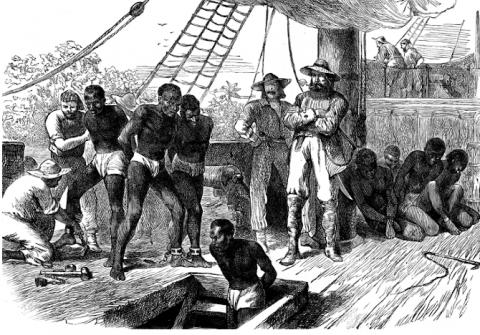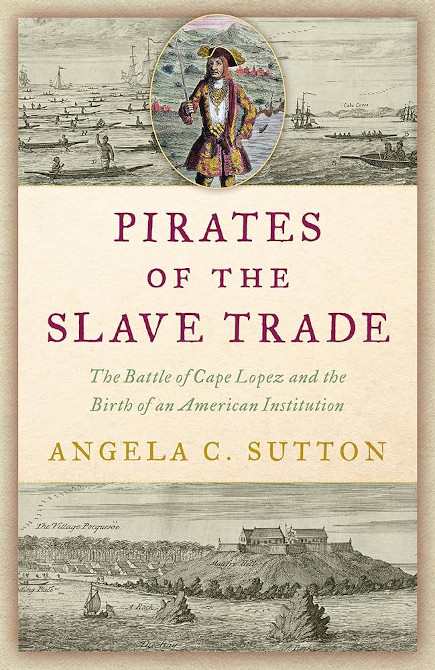How a Battle Between Pirates and the British Navy Triggered the Spread of Chattel Slavery

In 1722, a British navy vessel helmed by Chaloner Ogle, a social-climbing captain with a mandate to end piracy, secured a decisive win in the waters off the coast of present-day Gabon. In the Battle of Cape Lopez, Ogle and his crew faced off against an infamous pirate band led by Bartholomew “Black Bart” Roberts. The defeat of one of the most prolific pirate crews gave the British dominance in the slave trade and curtailed the piracy that had so often scuttled their dealings with West African slave traders. While few in the United States know about the Battle of Cape Lopez, its role in shaping the horrific form of slavery that took hold here and its impact on the course of American history is pivotal.
Specifically, in the Americas, the ascendence and systemization of the British trade was the catalyst for the emergence of chattel slavery. Settlers departed from the Roman-derived systems of slavery, which afforded the enslaved some basic rights, after the Battle of Cape Lopez and moved toward a legacy of total ownership and dominion over their involuntary workforce and any future descendants in what is now referred to as the chattel model. The Roman system, which had been practiced by other European powers who saw their empires and international influence wane at this time, was incompatible with the aims of British American planters.
Before the 18th century and this dramatic shift, the Portuguese were the first and central European participants in the slave trade who set the tone for enslavement in the Atlantic world. They brought with them to the trade the Roman understanding of slavery. Under the systems of the Roman Empire, enslavement was often a temporary state of being, not a permanent identity. Enslavers could claim the labor of their enslaved, but not their full personhood. Enslaved people had a lesser status and fewer rights, yet some of their key human rights remained recognized. They could and did make use of the legal system, suing enslavers for cruel treatment, for their emancipation, or for the emancipation of their children. The Portuguese enshrined this system of enslavement in West Central Africa and Brazil beginning in the 1500s.
Enslavement in the 1600s Dutch Atlantic world tended to follow suit. The Dutch began their forays into trafficking in West Africa by emulating their first competitors, the Portuguese, and also following their lead in the Americas, particularly in what would later become the United States. On the Gold Coast, some Africans enslaved unlawfully by the Dutch were able to avail themselves of the Dutch courts to appeal for freedom. In New Netherlands, in the area including parts of present-day New York and Delaware, records reflect enslaved people purchasing their freedom and formerly enslaved Africans marrying free Dutch people in the mid-1600s. Enslaved Africans and their descendants earned wages that they were permitted to keep, worshipped in the Dutch Reformed Church alongside White and free Black settlers, and some owned farmland in Manhattan. They appear with regularity in church and court records, testifying on their own behalf and insisting on their rights. It is not until the English began importing Africans in its takeover of New Netherlands in 1664 that more rigid race-based rules and racial designations took hold in the region.

By contrast, the British Empire were relative latecomers to the slave trade. They had been trading in Africa since the 1600s, but it took them longer to get a foothold in the trade. In the Atlantic world, they spent the first half of the 17th century battling the other European empires for Caribbean and West African territory and mercantile opportunities. Unlike their Portuguese, Spanish, Dutch, and French competition, Britain’s colonies in North America were administered under a variety of companies and stakeholders, and each colony was created for its own purposes and therefore had its own regulations regarding enslavement. Each procured forced African labor in a variety of ways, often relying on the illicit inter-American market when the British Royal Africa Company (RAC) was unable to meet the voracious demand of colonists. As demand grew and supply did not keep up, colonists stripped more and more rights and freedoms from the enslaved populations to ensure maximum extraction of their labor and the labor of their children. In these ways, the aftereffects of the Battle of Cape Lopez had devastating consequences for what would become the United States.
The increase in the slave trade volume afforded by the British maritime victory allowed British settlers to reject the Portuguese, Dutch, French, and Spanish notions of enslavement modeled after the Roman system, which had become the norm in the Atlantic world. Instead, they adopted the economically efficient chattel model in all their American colonies. This model spread as neighboring colonies, such as French Louisiana and Spanish Florida, became part of the United States after Louisiana was admitted to the union (1812) and the ratification of the Adams-Onis treaty (1821).
Under this new model of slavery, the enslaved were described as chattel, a word that shares its root with cattle, one of the most important forms of nonhuman capital at the time and in the history of the world. The ramifications for the enslaved were dire: slavery became a permanent identity, passed along generations. Enslavers claimed not only the labor of those they enslaved, but their entire beings. There was little to no legal recourse for the enslaved who experienced severe punishments nor was there any justice for the enslaved who were tortured and murdered by their enslavers. People with slave status could not testify in court, because for the first time in the Atlantic system, they were legally considered objects rather than human beings.
The economic efficiency of chattel slavery coincided with the rising popularity of capitalism, and this caused the widespread adoption of this British-introduced model across most of what would become the slaveholding United States and beyond. This is why, for example, other European colonies created in the Americas after this date, like Dutch Suriname, tended more toward the British chattel model.

The results were catastrophic and their reverberations far-reaching. The United States would not confer citizenship onto the enslaved, freed men, or their descendants, until the ratification of the Fourteenth Amendment in 1868—183 years after the French Empire granted citizenship to this population among her colonies.
Just as the enslaved were affected by this transition to a chattel model, so were the enslavers and the nonslaveholding colonists of European descent. This slavery transformed the cultures of the colonists. The all-encompassing nature of chattel slavery created a new type of identity politics: It conditioned people of European ancestry to think of themselves as White and to define themselves in opposition to Black people. This in turn sowed poisonous divisions that Americans still reap today.
Slavery has existed in nearly every society in the world in some form or another. Until British Atlantic societies developed the chattel model, no form of enslavement gave such complete and utter dominion to enslavers on such a scale. Consequently, no society had organized its entire social, political, religious, and economic systems around the exploitation of a more or less permanently enslaved underclass. Over time, the British North American territories became slave societies rather than a society with slaves. The distinction between a society with slaves and a slave society is important. Historian Ira Berlin first noted this in 1998. The British North American colonies began as societies with enslaved people with the charter generations. Race and slavery were more fluid designations, and many free people of African descent took part in many levels of society. Over time, as plantation systems emerged, the colonies became slave societies, wherein every aspect of the society hinged upon the strictures of slavery, and opportunities for people of African descent shrank dramatically.
To maintain generational wealth and power—or at least the dream of it—Whites had to participate and coerce the participation of other Whites in the system of White supremacy that dehumanizes the enslaved other. Colonial American lawmakers made informing on self-emancipating enslaved people and slave-catching mandatory for all White people, whether they personally enslaved anyone or not, whether they supported or opposed the institution. Mandatory reporting meant that failure to inform authorities when an enslaved person was doing anything they were not permitted to do could result in punishment. Legislators in many Southern colonies even formed groups that chased enslaved persons who dared attempt to “steal” themselves by escaping enslavement or by self-emancipating. These groups of White Southerners were expected to discipline enslaved people who were found off their plantations and to guard known escape routes. They were also the genesis of modern sheriff departments.

This social order mandated that the children born of an enslaved person would be born into slavery themselves. For slavery to be heritable, this type of system required a strict delineation between those with enslaved status and those without it. The ability to transfer from one status to another—as the enslaved often did in West Africa and, to lesser extents, elsewhere in the 16th- and 17th-century Atlantic world—became a liability in this system, as did racial ambiguity. To keep this system stable, enslavers tied visible Blackness to the status of enslavement. This meant that Africans in the British North American colonies were, according to Ibram X. Kendi, citing a particularly noxious speech of Jefferson Davis, “stamped from the beginning.”
Everyone who profited from the bloody and brutal trade in slaves made the decision to embark on ventures that resulted in African enslavement and death. They all justified these ventures, after the fact, in the letters and narratives they left behind. And the people today who read their writings and say things like “well, that was normal then” or “they didn’t know any better” or “that was just the way things were” are missing the point. It was not normal then.
They did know better, and that was not just the way things were. That was the way these men who trafficked human beings after the Battle of Cape Lopez actively created things. If it had ever been normal, moral, and acceptable to profit from the dehumanization of millions of people and to steal their labor, personhood, and that of their descendants in perpetuity, they would not have written thousands of pages of anti-abolitionist propaganda to convince the readership otherwise after the Battle of Cape Lopez, and during the birth of American slavery.
Adapted from the new book, Pirates of the Slave Trade: The Battle of Cape Lopez and the Birth of an American Institution. Published with permission.
Author Bio:
Angela C. Sutton is the author of Pirates of the Slave Trade: The Battle of Cape Lopez and the Birth of an American Institution. She is an assistant research professor at Vanderbilt University, where she has taught Seapower in History, the Golden Age of Piracy, and Comparative Slavery.
Highbrow Magazine
Photo credits: Depositphotos.com; Wikipedia Commons; Wikipedia Commons.































































































































































































































































































































